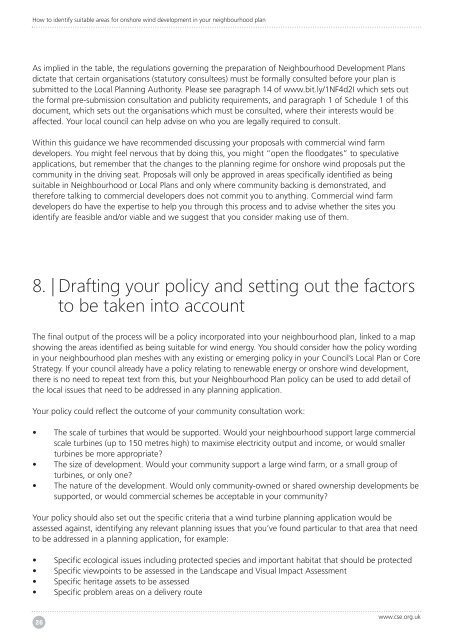neighbourhood-planning-wind-guidance
neighbourhood-planning-wind-guidance
neighbourhood-planning-wind-guidance
You also want an ePaper? Increase the reach of your titles
YUMPU automatically turns print PDFs into web optimized ePapers that Google loves.
How to identify suitable areas for onshore <strong>wind</strong> development in your <strong>neighbourhood</strong> plan<br />
As implied in the table, the regulations governing the preparation of Neighbourhood Development Plans<br />
dictate that certain organisations (statutory consultees) must be formally consulted before your plan is<br />
submitted to the Local Planning Authority. Please see paragraph 14 of www.bit.ly/1NF4d2I which sets out<br />
the formal pre-submission consultation and publicity requirements, and paragraph 1 of Schedule 1 of this<br />
document, which sets out the organisations which must be consulted, where their interests would be<br />
affected. Your local council can help advise on who you are legally required to consult.<br />
Within this <strong>guidance</strong> we have recommended discussing your proposals with commercial <strong>wind</strong> farm<br />
developers. You might feel nervous that by doing this, you might “open the floodgates” to speculative<br />
applications, but remember that the changes to the <strong>planning</strong> regime for onshore <strong>wind</strong> proposals put the<br />
community in the driving seat. Proposals will only be approved in areas specifically identified as being<br />
suitable in Neighbourhood or Local Plans and only where community backing is demonstrated, and<br />
therefore talking to commercial developers does not commit you to anything. Commercial <strong>wind</strong> farm<br />
developers do have the expertise to help you through this process and to advise whether the sites you<br />
identify are feasible and/or viable and we suggest that you consider making use of them.<br />
8. | Drafting your policy and setting out the factors<br />
to be taken into account<br />
The final output of the process will be a policy incorporated into your <strong>neighbourhood</strong> plan, linked to a map<br />
showing the areas identified as being suitable for <strong>wind</strong> energy. You should consider how the policy wording<br />
in your <strong>neighbourhood</strong> plan meshes with any existing or emerging policy in your Council’s Local Plan or Core<br />
Strategy. If your council already have a policy relating to renewable energy or onshore <strong>wind</strong> development,<br />
there is no need to repeat text from this, but your Neighbourhood Plan policy can be used to add detail of<br />
the local issues that need to be addressed in any <strong>planning</strong> application.<br />
Your policy could reflect the outcome of your community consultation work:<br />
• The scale of turbines that would be supported. Would your <strong>neighbourhood</strong> support large commercial<br />
scale turbines (up to 150 metres high) to maximise electricity output and income, or would smaller<br />
turbines be more appropriate?<br />
• The size of development. Would your community support a large <strong>wind</strong> farm, or a small group of<br />
turbines, or only one?<br />
• The nature of the development. Would only community-owned or shared ownership developments be<br />
supported, or would commercial schemes be acceptable in your community?<br />
Your policy should also set out the specific criteria that a <strong>wind</strong> turbine <strong>planning</strong> application would be<br />
assessed against, identifying any relevant <strong>planning</strong> issues that you’ve found particular to that area that need<br />
to be addressed in a <strong>planning</strong> application, for example:<br />
• Specific ecological issues including protected species and important habitat that should be protected<br />
• Specific viewpoints to be assessed in the Landscape and Visual Impact Assessment<br />
• Specific heritage assets to be assessed<br />
• Specific problem areas on a delivery route<br />
26<br />
www.cse.org.uk


